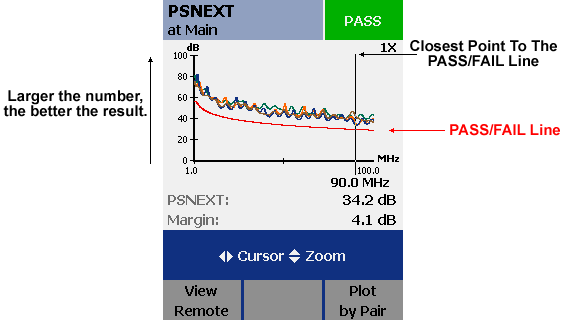Power Sum NEXT (PS NEXT)
 Power Sum NEXT (PS NEXT) is a calculation, not a measurement. PS NEXT is derived from the summation of the individual NEXT effects on each pair by the other three pairs. PS NEXT is important measurements for qualifying cabling intended to support 4 pair transmission schemes such as Gigabit Ethernet, although IEEE 802.3ab does not specifically require PS NEXT. If you run the specific Gigabit Ethernet test within the field tester, you will see that PS NEXT is not recorded. There are four PS NEXT results at each end of the link per link tested.
Power Sum NEXT (PS NEXT) is a calculation, not a measurement. PS NEXT is derived from the summation of the individual NEXT effects on each pair by the other three pairs. PS NEXT is important measurements for qualifying cabling intended to support 4 pair transmission schemes such as Gigabit Ethernet, although IEEE 802.3ab does not specifically require PS NEXT. If you run the specific Gigabit Ethernet test within the field tester, you will see that PS NEXT is not recorded. There are four PS NEXT results at each end of the link per link tested.
Results Interpretation
Since PS NEXT is a measure of difference in signal strength between disturbing pairs and a disturbed pair, a larger number (less crosstalk) is more desirable than a smaller number (more crosstalk). Because PS NEXT varies significantly with frequency, it is important to measure it across a range of frequencies, typically 1 – 100 MHz. If you look at the PS NEXT on a 50 meter segment of twisted pair cabling, it has a characteristic "roller coaster" shape.

That is, it varies up and down significantly, while generally increasing in magnitude. This is because twisted pair coupling becomes less effective for higher frequencies. Typically, PS NEXT results are around 3 dB lower than the worst-case NEXT result at each end of the link.
Troubleshooting Recommendations
Since PS NEXT is a calculation based on NEXT measurements, troubleshooting for PS NEXT failures reduces to troubleshooting for NEXT problems. Once you have isolated and repaired the NEXT problem, PS NEXT will automatically improve.(Troubleshooting NEXT requires a field tester with the ability to look down the cable and see where the crosstalk is happening.)






